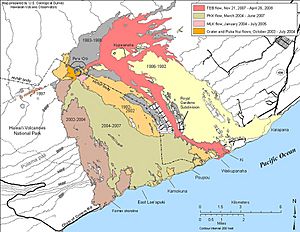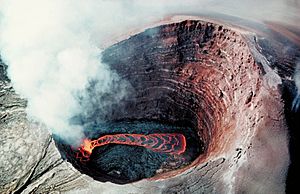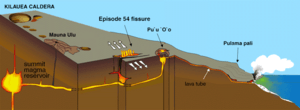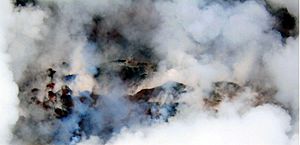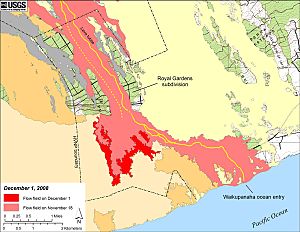Puʻu ʻŌʻō facts for kids
Quick facts for kids Puʻu ʻŌʻō |
|
|---|---|
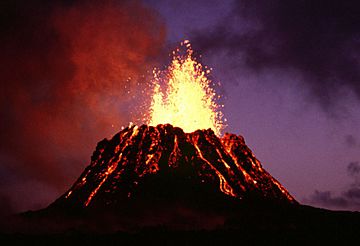
View at dusk, June 1983
|
|
| Highest point | |
| Elevation | 2,290 ft (700 m) |
| Geography | |
| Location | Hawaii County, Hawaii, US |
| Parent range | Hawaiian Islands |
| Topo map | USGS Kalalua |
| Geology | |
| Age of rock | 43 years |
| Mountain type | Cinder/spatter cone |
| Volcanic arc/belt | Hawaiian-Emperor seamount chain |
| Last eruption | 1983–2018 |
Puʻu ʻŌʻō (pronounced poo-oo OH-oh) is a special kind of volcanic cone on the Kīlauea volcano in the Hawaiian Islands. It's located in the eastern rift zone, which is a long crack where magma can escape. From January 3, 1983, until April 2018, Puʻu ʻŌʻō erupted almost non-stop. This made it the longest-running eruption from a rift zone in the last 200 years!
Over time, the lava from Puʻu ʻŌʻō covered a huge area, about 45 square miles (117 km²). It even added 230 acres (0.93 km²) of new land to the southeast coast of Hawaiʻi. Sadly, the eruption destroyed many things. At least 189 buildings, 9 miles (14 km) of highways, a church, a store, and old Hawaiian sites were lost. The coastal highway has been closed since 1987 because parts of it are buried under lava up to 115 feet (35 m) thick.
Contents
What's in a Name?
At first, scientists called this new hill "Puʻu O." This was because its spot on their map lined up with an "o" in the words "Lava flow of 1965." Later, older people from the village of Kalapana were asked to give it a proper name. They chose Puʻu ʻŌʻō, which means hill of the digging stick. Some people also translate the name as "Hill of the ʻŌʻō Bird", which is a type of Hawaiian bird.
How Puʻu ʻŌʻō Formed and Changed
1983 – 1986: Giant Lava Fountains Build a Cone
The Puʻu ʻŌʻō eruption started on January 3, 1983. Cracks opened in the ground in the remote rainforest of the eastern rift zone. By June 1983, the eruption became stronger and focused on the Puʻu ʻŌʻō vent. For the next three years, there were 44 times when lava shot high into the air. These "lava fountains" could reach as high as 1,500 feet (460 m)! The ash and rock bits falling from these fountains built a cone 837 feet (255 m) tall.
1986 – 1991: Lava Moves East to Kūpaʻianahā
In July 1986, the path for the magma to Puʻu ʻŌʻō broke. The eruption suddenly moved about 2 miles (3 km) east to a new spot called Kūpaʻianahā. This new vent brought a different kind of eruption. Instead of tall fountains, there was a steady, quiet flow from a lava lake. After a few weeks, a roof formed over the main lava channel, creating a lava tube. Lava tubes are like underground tunnels that keep the hot, flowing lava warm, allowing it to travel long distances.
In less than a year, lava overflowing from the lake built a wide, low shield about 180 feet (55 m) above Kūpaʻianahā. In November 1986, lava flows reached the town of Kapaʻahu. It covered the coastal highway and flowed into the ocean about 7.5 miles (12 km) from the vent. A few weeks later, the lava moved east and buried 14 houses in Kalapana in just one day.
The eruption became most destructive in 1990. Lava flows turned eastward and completely destroyed the villages of Kalapana and Kaimū. Kaimū Bay and Kalapana Black Sand Beach were also covered by lava. Over 100 homes were destroyed in nine months. New lava tubes then sent the lava away from Kalapana in early 1991, and the lava started flowing into the ocean again within Hawaii Volcanoes National Park.
1992 – 2013: Steady Lava Flows
The amount of lava from Kūpaʻianahā slowly decreased through 1991, and the vent stopped erupting in early 1992. The eruption then returned to Puʻu ʻŌʻō. New vents on the sides of the cone built a new lava shield. Soon, lava tubes were carrying lava from these vents all the way to the ocean, with very few flows on the surface. These side vents have been the main source of activity ever since. There was a short two-month break in 1997 after a brief eruption in Nāpau Crater, which is southwest of Puʻu ʻŌʻō.
On January 29, 1997, a series of earthquakes shook Kīlauea's east rift zone. Deep inside the rift zone, magma was escaping from the path leading to Puʻu ʻŌʻō. This cut off the lava supply to the ongoing eruption. The lava pond at Puʻu ʻŌʻō drained, and people 10 miles (16 km) away heard a low rumbling sound. The crater floor dropped 500 feet (150 m), and the west wall of the Puʻu ʻŌʻō cone collapsed. A few hours later, magma found a new way to the surface. The ground cracked in nearby Nāpau Crater, and lava fountains lit up the night sky. However, this activity didn't last long, and the eruption soon moved back to Puʻu ʻŌʻō.
By January 2007, 3.1 cubic km of lava had covered 45 square miles (117 km²) and added 201 acres (0.81 km²) to Kīlauea's southern shore. The new shoreline was 9.7 miles (15.6 km) long. The lava flows had destroyed 189 buildings and covered 8.7 miles (14 km) of highway with as much as 115 feet (35 m) of lava.
In 2007, after some earthquakes, activity in Puʻu ʻŌʻō slowed down, and the crater floor collapsed. No glowing lava was seen in the crater after August. Lava then started coming out of cracks in the northeast rift zone. It spread slowly east and south as a "perched flow," which means it built up its own channel. This lava mostly flowed over older lava from 1983–1986, with only small amounts going into nearby forests.
In late July 2008, more lava flows came from the eastern vents of Puʻu ʻŌʻō. In October, many new cracks opened up along the lava tube. The lava spread into the Royal Gardens Subdivision and covered a large area of the coastal flats in November 2008.
On March 5, 2011, the floor of the Puʻu ʻŌʻō crater sank down, then collapsed. Two hours later, a new eruption began in Kīlauea's middle east zone, between Puʻu ʻŌʻō and Napau Crater. Lava fountains were reported to be 65 feet (20 m) high.
By March 26, 2011, lava began to fill the crater floor again. The USGS HVO webcam showed it. By June 1, the lava had filled the crater floor to about 128 feet (39 m) below the eastern crater rim.
On September 21, 2011, lava from the west lava lake in Puʻu ʻŌʻō Crater flowed down the west side of the cone. Around 2:25 AM UTC on September 21, the activity in the crater and the western overflows suddenly stopped. This happened because lava broke through the upper east side of Puʻu ʻŌʻō, bypassing the crater. The new crack fed a fast-moving, channelized ʻaʻā lava flow that went about 1.6 miles (2.5 km) southeast. A second flow started the next day to the west of the first one. Also, a small amount of lava refilled the bottom of the drained east lava lake, and small flows were active at the west edge of Puʻu ʻŌʻō Crater.
The channelized ʻaʻā lava flow reached 2.3 miles (3.7 km) long on September 23, then stopped within the Kahauale'a Natural Area Reserve. Most of the active lava spread south and west of Pu'u Halulu (about 0.8 miles (1.3 km) northeast of Puʻu ʻŌʻō) from September 23–27. Minor lava activity started again inside Pu'u 'O'o Crater. Short lava flows came from the base of the east wall on September 25 and from the west wall base on September 25–26. The crater floor of Puʻu ʻŌʻō slowly sank. Lava activity resumed within the east lake on September 26. The crater floor continued to sink from September 26–27, opening cracks in the north crater floor.
The 2011 activity eventually destroyed all the remaining homes in the Royal Gardens Subdivision.
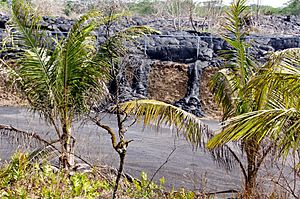
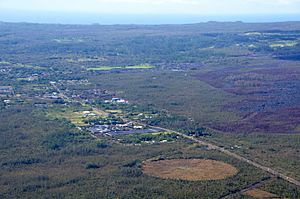
2014 – 2016: Lava Threatens Pāhoa
On June 27, 2014, new vents opened on the northeast side of the Puʻu ʻŌʻō cone. These vents fed a narrow lava flow to the east-northeast. On August 18, the lava flow entered a crack in the ground. It traveled underground for several days, then came back to the surface to form a small lava pond. This happened two more times in the following days. The lava entered other cracks and reappeared further downhill. By September 3, the flow had moved about 8.2 miles (13.2 km) from the vent. It was only 0.8 miles (1.3 km) from the eastern edge of the Wao Kele o Puna Forest Reserve. The lava flow moved northeast at different speeds. By October 31, it had entered the village of Pāhoa and was within 27 yards (25 meters) of the waste recycling center.
In December 2014, a steady lava breakout from this flow (called the "June 27 flow") threatened to enter the town of Pāhoa. It also threatened to cut Highway 130, which was the only road into and out of Lower Puna. Because of this, work began to reopen Chain of Craters Road as a gravel road for emergencies. Railroad Avenue and Government Beach Road were also made ready as emergency routes. However, the lava flow stopped just before it entered Pāhoa.
By March 2015, the June 27 flow had moved back to within 3.7 miles (6 km) of Pu‘u ‘Ō‘ō. This greatly reduced the danger to Pāhoa. Lava from the June 27 flow remained active in this area for the rest of 2015.
On May 24, 2016, a new vent opened on the east side of Pu‘u ‘Ō‘ō. This cut off the lava supply to the June 27th flow, which became inactive by June 8, 2016. Lava from the new vent, called the "61g" flow, went south and started flowing into the ocean at Kamokuna on July 26, 2016. Lava from the 61g flow covered part of the Chain of Craters Road. The road is now kept flat for authorities to use, but it is no longer open to the public.
2018: Pu‘u ‘Ō‘ō Stops, Eruption Moves to Lower East Rift Zone
On April 30, 2018, the Pu‘u ‘Ō‘ō crater floor collapsed. Lava drained out and flowed underground about 10 miles (16 km) down the rift zone. People living in the Puna area, on the southeast coast of the island, were asked to leave their homes. On May 3, 2018, a 4.6 magnitude earthquake happened off the south side of the volcano. The USGS reported that there were almost 70 earthquakes of magnitude 2.5 or stronger from May 1 to May 2. On May 3, cracks opened up at Leilani Estates. These new cracks from the lower Puna eruption became the active area of the eruption, replacing the 61g flow. After this, work continued to make the Chain of Craters Road usable as an escape route for nearby areas.
Scientists at the USGS think it's unlikely that magma will return to Pu‘u ‘Ō‘ō. However, they also noted that Pu‘u ‘Ō‘ō has stopped erupting for as long as six years in the past, during which time the activity moved to other vents on Kīlauea.
See also
 In Spanish: Puʻu ʻŌʻō para niños
In Spanish: Puʻu ʻŌʻō para niños


